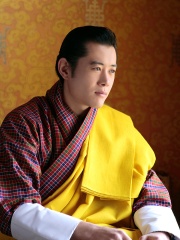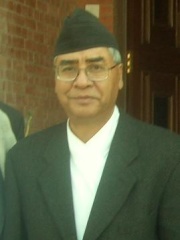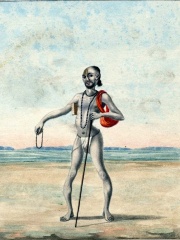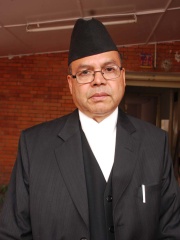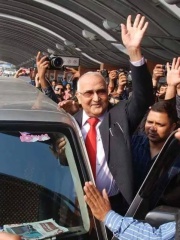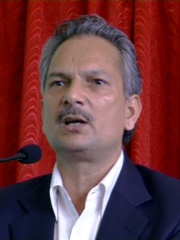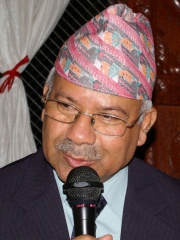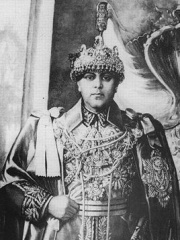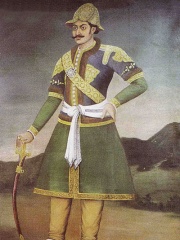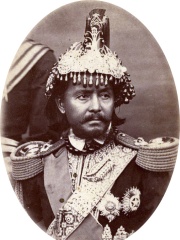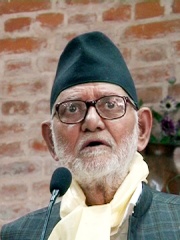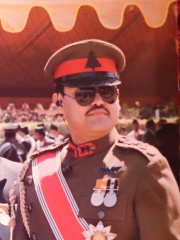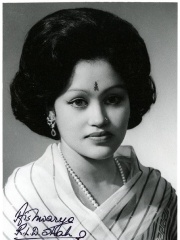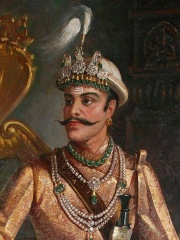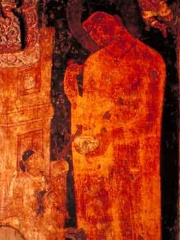
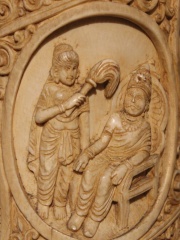
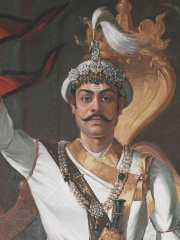
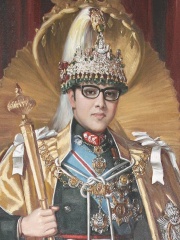
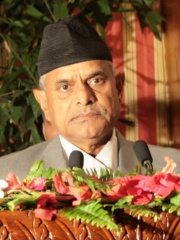
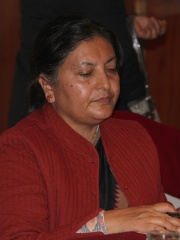
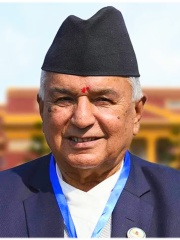
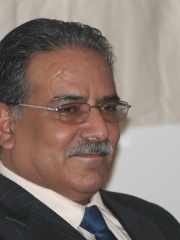
The Most Famous
POLITICIANS from Nepal
This page contains a list of the greatest Nepalese Politicians. The pantheon dataset contains 19,576 Politicians, 30 of which were born in Nepal. This makes Nepal the birth place of the 80th most number of Politicians behind Indonesia, and Azerbaijan.
Top 10
The following people are considered by Pantheon to be the top 10 most legendary Nepalese Politicians of all time. This list of famous Nepalese Politicians is sorted by HPI (Historical Popularity Index), a metric that aggregates information on a biography’s online popularity. Visit the rankings page to view the entire list of Nepalese Politicians.

1. Yaśodharā (b. -600)
With an HPI of 70.44, Yaśodharā is the most famous Nepalese Politician. Her biography has been translated into 34 different languages on wikipedia.
Yaśodharā (Pali: Yasodharā, Sanskrit: यशोधरा, romanized: Yaśodharā) was the wife of Prince Siddhartha — until he left his home to become a śramaṇa— the mother of Rāhula, and the sister of Devadatta. She later became a Bhikkhunī and is considered an arahatā.

2. Śuddhodana (b. -590)
With an HPI of 66.14, Śuddhodana is the 2nd most famous Nepalese Politician. His biography has been translated into 35 different languages.
Śuddhodana (Sanskrit: शुद्धोदन; Pali: Suddhodana), meaning "he who grows pure rice," was the father of Siddhartha Gautama, better known as the Buddha. He was a leader of the Shakya, who lived in an oligarchic republic, with their capital at Kapilavastu. In later renditions of the life of the Buddha, Śuddhodana was often referred to as a king, though that status cannot be established with confidence and is in fact disputed by modern scholars.

3. Prithvi Narayan Shah (1723 - 1775)
With an HPI of 59.84, Prithvi Narayan Shah is the 3rd most famous Nepalese Politician. His biography has been translated into 35 different languages.
Maharajadhiraj Prithvi Narayan Shah (Nepali: श्री ५ बडामहाराजाधिराज पृथ्वीनारायण शाह देव), (7 January 1723 – 11 January 1775), was the last King of the Gorkha Kingdom and first King of the Kingdom of Nepal (also called the Kingdom of Gorkha). Prithvi Narayan Shah started the unification of Nepal.Prithvi Narayan Shah is considered the Father of the Nation in Nepal.

4. Birendra of Nepal (1945 - 2001)
With an HPI of 59.35, Birendra of Nepal is the 4th most famous Nepalese Politician. His biography has been translated into 45 different languages.
Birendra Bir Bikram Shah Dev (Nepali: श्री ५ महाराजाधिराज वीरेन्द्र वीर विक्रम शाह देव), (28 December 1945 – 1 June 2001) was the tenth King of Nepal from 1972 until his assassination in 2001. He was the eldest son of King Mahendra.
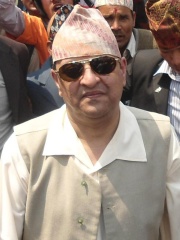
5. Gyanendra of Nepal (b. 1947)
With an HPI of 58.98, Gyanendra of Nepal is the 5th most famous Nepalese Politician. His biography has been translated into 49 different languages.
Gyanendra Bir Bikram Shah Dev (Nepali: ज्ञानेन्द्र वीर विक्रम शाह देव; born 7 July 1947) is a former monarch and the last King of Nepal, reigning from 2001 to 2008. As a child, he was briefly king from 1950 to 1951, when his grandfather, Tribhuvan, took political exile in India with the rest of his family. His second reign began after the 2001 Nepalese royal massacre. Gyanendra Shah is the first person in the history of Nepal to be king twice and the last king of the Shah dynasty of Nepal.Gyanendra's second reign was marked by constitutional turmoil. His brother King Birendra had established a constitutional monarchy in which he delegated policy to a representative government. The growing insurgency of the Nepalese Civil War during Gyanendra's reign interfered with the elections of representatives. After several delays in elections, Gyanendra suspended the constitution and assumed direct authority in February 2005, asserting that it would be a temporary measure to suppress the Maoist insurgency after civil governments had failed to do so. In the face of broad opposition, he restored the previous parliament in April 2006. He was deposed two years later by the first session of the Constituent Assembly, which declared the nation to be the Federal Democratic Republic of Nepal and abolished the 240-year-old Shah dynasty.

6. Ram Baran Yadav (b. 1948)
With an HPI of 57.25, Ram Baran Yadav is the 6th most famous Nepalese Politician. His biography has been translated into 56 different languages.
Ram Baran Yadav (Maithili: डा. राम वरण यादव; born 4 February 1948) is a Nepali politician and physician who served as the first president of Nepal from 23 July 2008 to 29 October 2015, following the declaration of republic in 2008. Previously he served as Minister of Health from 1999 to 2001 and general secretary of the Nepali Congress.

7. Bidhya Devi Bhandari (b. 1961)
With an HPI of 56.21, Bidhya Devi Bhandari is the 7th most famous Nepalese Politician. Her biography has been translated into 76 different languages.
Bidya Devi Bhandari (Nepali: विद्यादेवी भण्डारी, pronounced [bid̚djadebi bʱʌɳɖaɾi]; born 19 June 1961) is a Nepali former politician who served as the second president of Nepal from 2015 to 2023. She formerly served as the minister of defence and minister of environment and population. She was the first woman to hold the office in the country. She served as the vice-chairperson of the Communist Party of Nepal (Unified Marxist–Leninist) and was the chair of the All Nepal Women's Association before being elected president. Bhandari previously served as the Minister of Defence, the first woman to hold the office, from 2009 to 2011. She also served as the Minister of Environment and Population in 1997, and has been an active campaigner for environmental awareness and women's rights in Nepal. In June 2017, she visited the headquarters of the International Union for Conservation of Nature in Gland, Switzerland and met with the director general Inger Andersen to discuss enhanced collaboration on nature conservation and sustainable development. In 2016, Forbes placed her as number 52 in their list of the world's 100 most powerful women.

8. Ram Chandra Poudel (b. 1944)
With an HPI of 55.46, Ram Chandra Poudel is the 8th most famous Nepalese Politician. His biography has been translated into 30 different languages.
Ram Chandra Paudel (Nepali: रामचन्द्र पौडेल; born 6 October 1944) is a Nepalese politician serving as the third president of Nepal, since 13 March 2023.A former senior leader of the Nepali Congress, Paudel previously served as the speaker of the House of Representatives from 1994 to 1999, and was the Deputy Prime Minister and Minister for Home Affairs from 1999 to 2002. First elected to parliament in 1991, he served in numerous other ministerial positions and was the Leader of Opposition from 2009 to 2013, as the parliamentary party leader of the Nepali Congress.

9. Pushpa Kamal Dahal (b. 1954)
With an HPI of 54.22, Pushpa Kamal Dahal is the 9th most famous Nepalese Politician. His biography has been translated into 47 different languages.
Pushpa Kamal Dahal (Nepali: पुष्पकमल दाहाल; born Ghanashyam Dahal, 11 December 1954), alias Prachanda (Nepali: प्रचण्ड, pronounced [prʌˈt͡sʌɳɖʌ], meaning "fierce"), is a Nepalese politician currently serving as the Prime Minister of Nepal. He previously held the prime ministerial post from 2008 to 2009 as the first prime minister of the Federal Democratic Republic of Nepal, and again from 2016 to 2017. He was elected as prime minister for the third time in 2022, following that year's elections. Dahal was born in Lewade, Dhikur Pokhari, a VDC 20 KM north from Pokhara, and spent most of his childhood in Chitwan, where he received a diploma of science in agriculture from Institute of Agriculture and Animal Science (IAAS) in Rampur, Chitwan. He joined left-wing political parties after seeing severe poverty in his youth. In 1981, he joined the Communist Party of Nepal (Fourth Convention), and later became general secretary of the Communist Party of Nepal (Mashal) in 1989. This party later became the Communist Party of Nepal (Maoist). Dahal was the leader of the Communist Party of Nepal (Maoist) during the country's civil war and subsequent peace process and the 1st Nepalese constituent assembly. In the 2008 elections, CPN(M) emerged as the largest party, and Dahal became prime minister in August of that year. He resigned from the post on 4 May 2009, after his attempt to sack the then army chief, General Rookmangud Katawal, was opposed by then President Ram Baran Yadav.Dahal was sworn in as prime minister for the second time in 2016, as per an agreement to form a rotational government by Congress and CPN (Maoist Centre). He resigned from the post of prime minister on 24 May 2017. Following the 2022 Nepalese general election, with an alliance with political parties including CPN (UML), Rastriya Swatantra Party and Rastriya Prajatantra Party, Dahal was sworn in as Prime Minister once again in 2022.
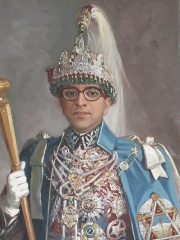
10. Mahendra of Nepal (1920 - 1972)
With an HPI of 53.46, Mahendra of Nepal is the 10th most famous Nepalese Politician. His biography has been translated into 31 different languages.
Mahendra Bir Bikram Shah Dev (Nepali: महेन्द्र वीर विक्रम शाह देव), (11 June 1920 – 31 January 1972) was the ninth King of Nepal from 13 March 1955 until his death in 1972, which was due to heart attack as told in an interview by his personal physician Dr. Mrigendra Raj Pandey. Following the 1960 coup d'état, he established the partyless Panchayat system which governed the country for 28 years until the introduction of multiparty democracy in 1990. During his reign, Nepal experienced a period of industrial, political and economic change which opened it to the rest of the world for the first time after the 104-year-long reign of the Rana rulers, who kept the country under an isolationist policy, came to an end in 1951.
People
Pantheon has 32 people classified as Nepalese politicians born between 600 BC and 1980. Of these 32, 12 (37.50%) of them are still alive today. The most famous living Nepalese politicians include Gyanendra of Nepal, Ram Baran Yadav, and Bidhya Devi Bhandari. The most famous deceased Nepalese politicians include Yaśodharā, Śuddhodana, and Prithvi Narayan Shah. As of April 2024, 1 new Nepalese politicians have been added to Pantheon including Ram Chandra Poudel.
Living Nepalese Politicians
Go to all RankingsGyanendra of Nepal
1947 - Present
HPI: 58.98
Ram Baran Yadav
1948 - Present
HPI: 57.25
Bidhya Devi Bhandari
1961 - Present
HPI: 56.21
Ram Chandra Poudel
1944 - Present
HPI: 55.46
Pushpa Kamal Dahal
1954 - Present
HPI: 54.22
Jigme Khesar Namgyel Wangchuck
1980 - Present
HPI: 52.63
Sher Bahadur Deuba
1946 - Present
HPI: 51.28
Ashtavakra
HPI: 49.77
Jhala Nath Khanal
1950 - Present
HPI: 46.46
KP Sharma Oli
1952 - Present
HPI: 44.94
Baburam Bhattarai
1954 - Present
HPI: 41.91
Madhav Kumar Nepal
1953 - Present
HPI: 41.85
Deceased Nepalese Politicians
Go to all RankingsYaśodharā
600 BC - Present
HPI: 70.44
Śuddhodana
590 BC - Present
HPI: 66.14
Prithvi Narayan Shah
1723 - 1775
HPI: 59.84
Birendra of Nepal
1945 - 2001
HPI: 59.35
Mahendra of Nepal
1920 - 1972
HPI: 53.46
Tribhuvan of Nepal
1906 - 1955
HPI: 53.27
Bhimsen Thapa
1775 - 1839
HPI: 51.11
Jung Bahadur Rana
1817 - 1877
HPI: 50.20
Sushil Koirala
1939 - 2016
HPI: 49.75
Dipendra of Nepal
1971 - 2001
HPI: 46.69
Queen Aishwarya of Nepal
1949 - 2001
HPI: 46.61
Rana Bahadur Shah
1775 - 1806
HPI: 45.93
Newly Added Nepalese Politicians (2024)
Go to all RankingsOverlapping Lives
Which Politicians were alive at the same time? This visualization shows the lifespans of the 16 most globally memorable Politicians since 1700.

